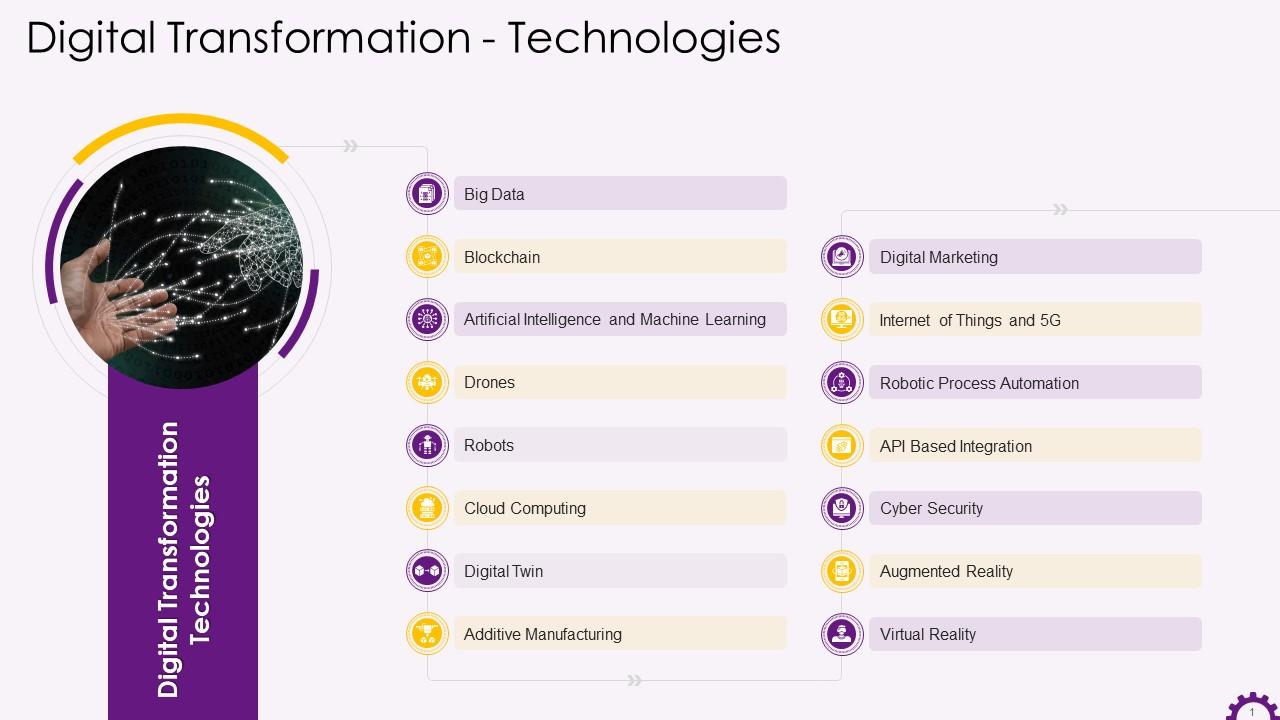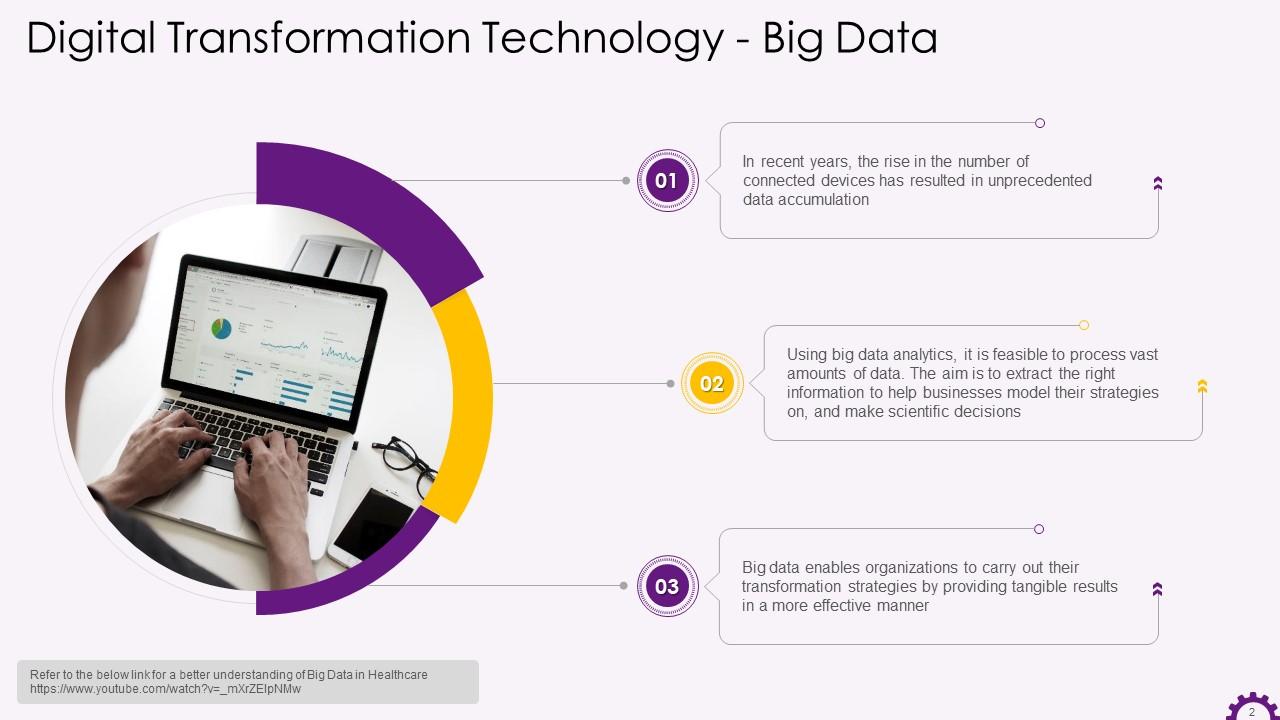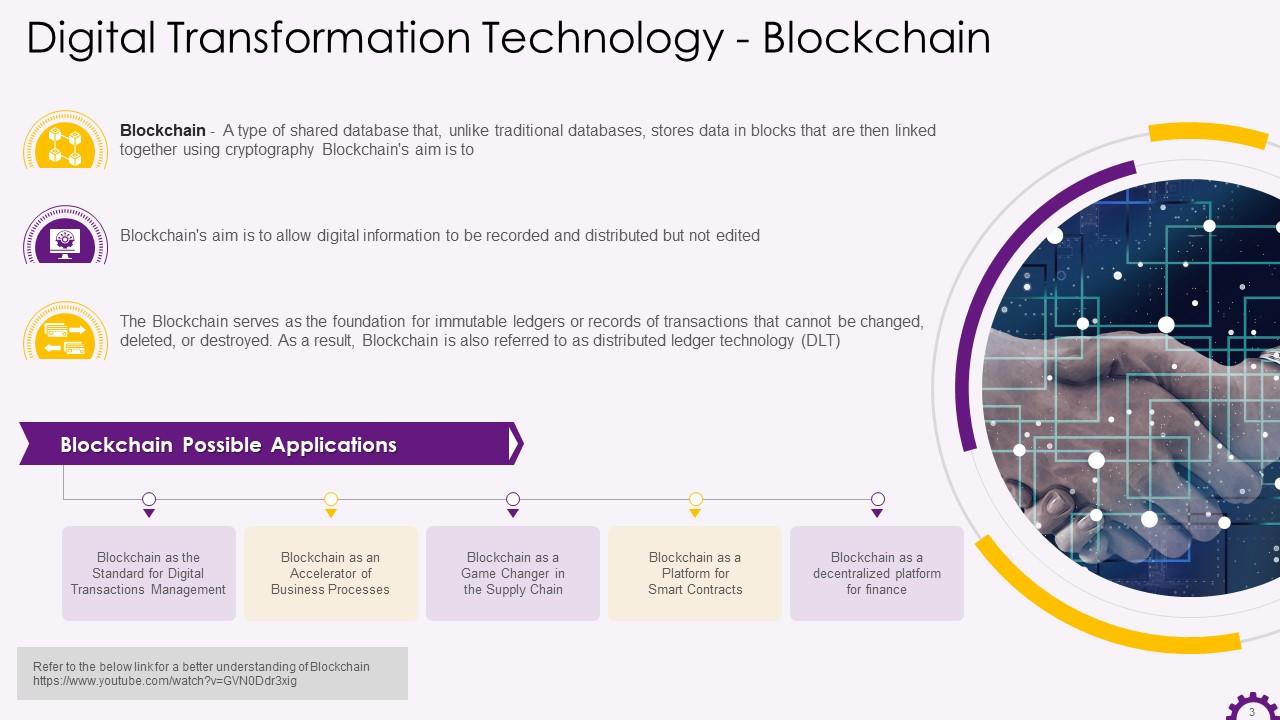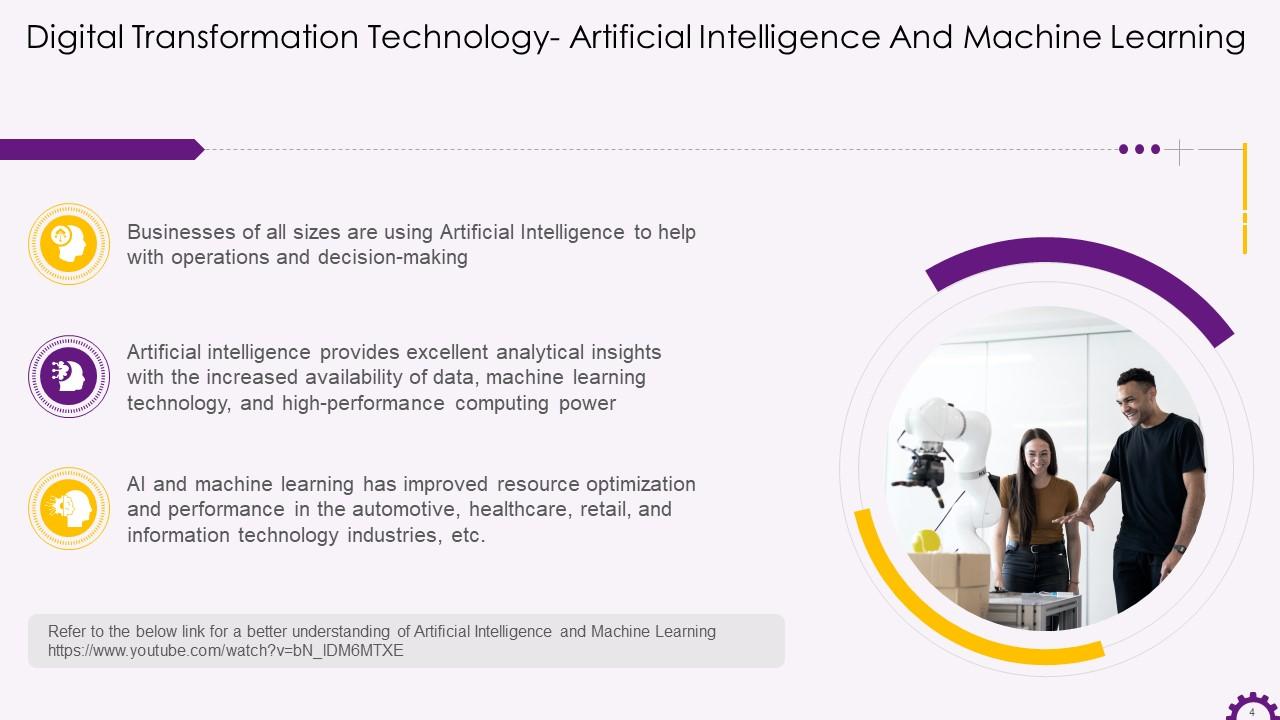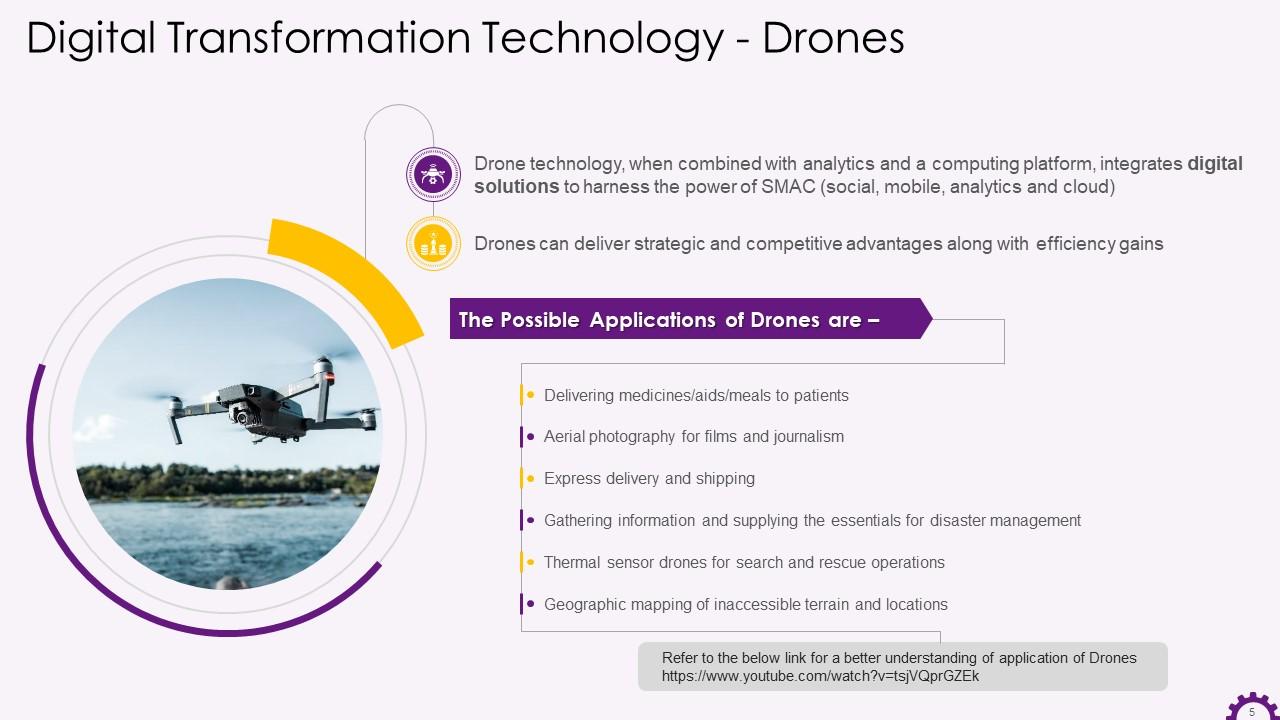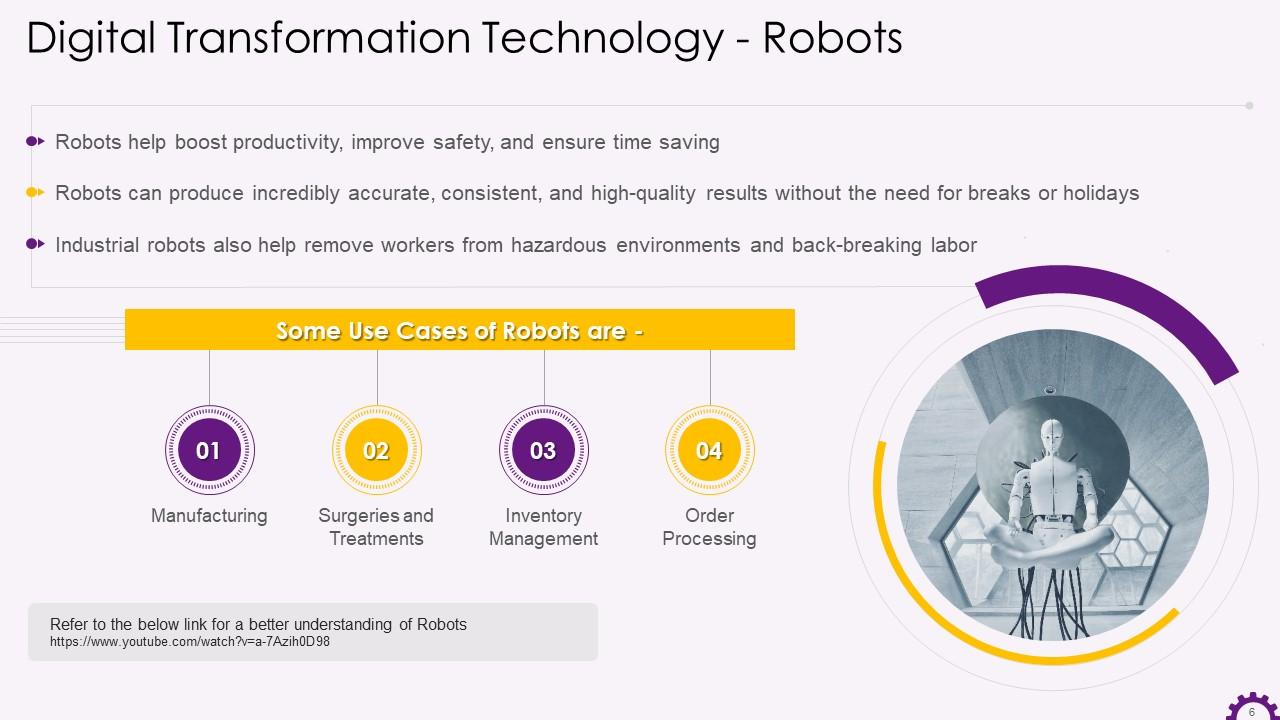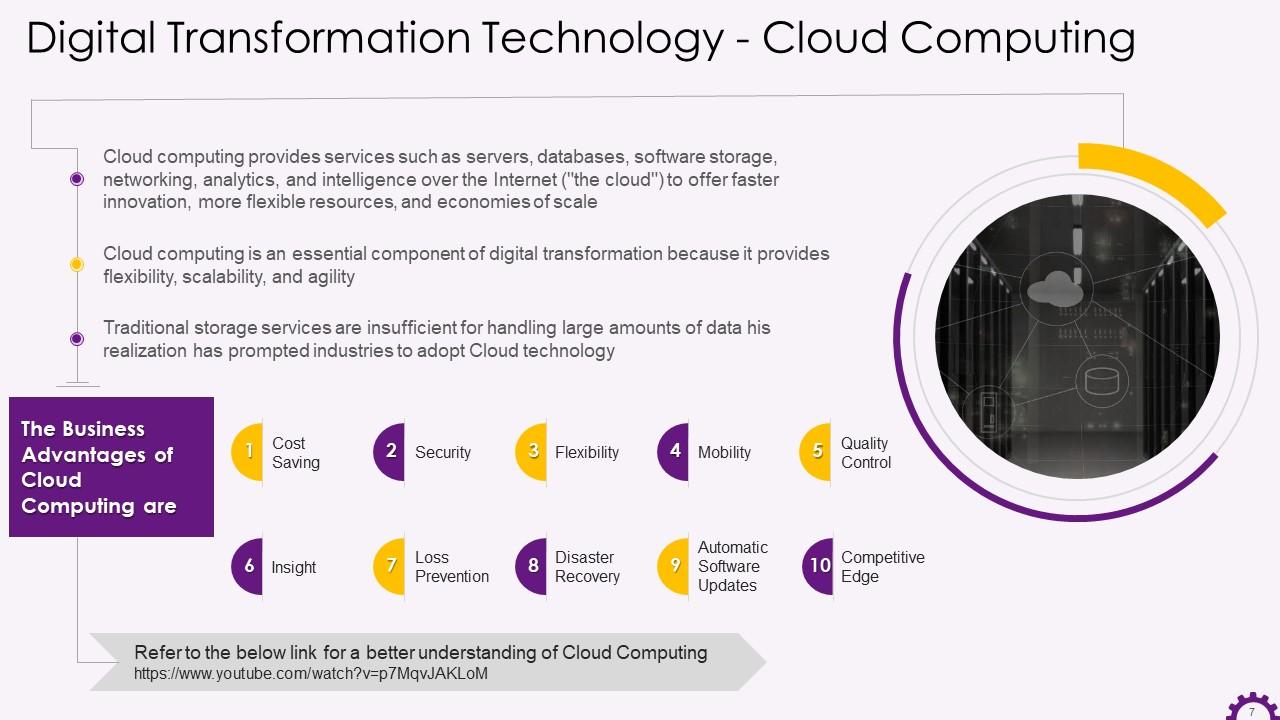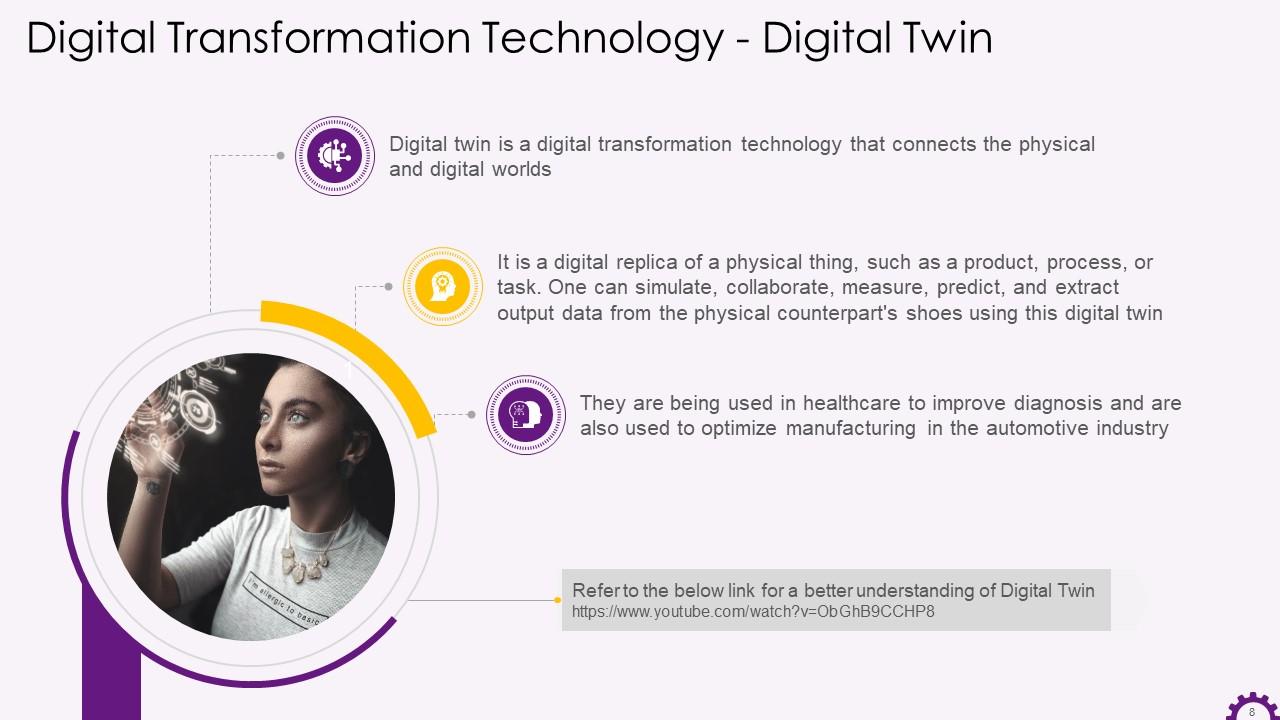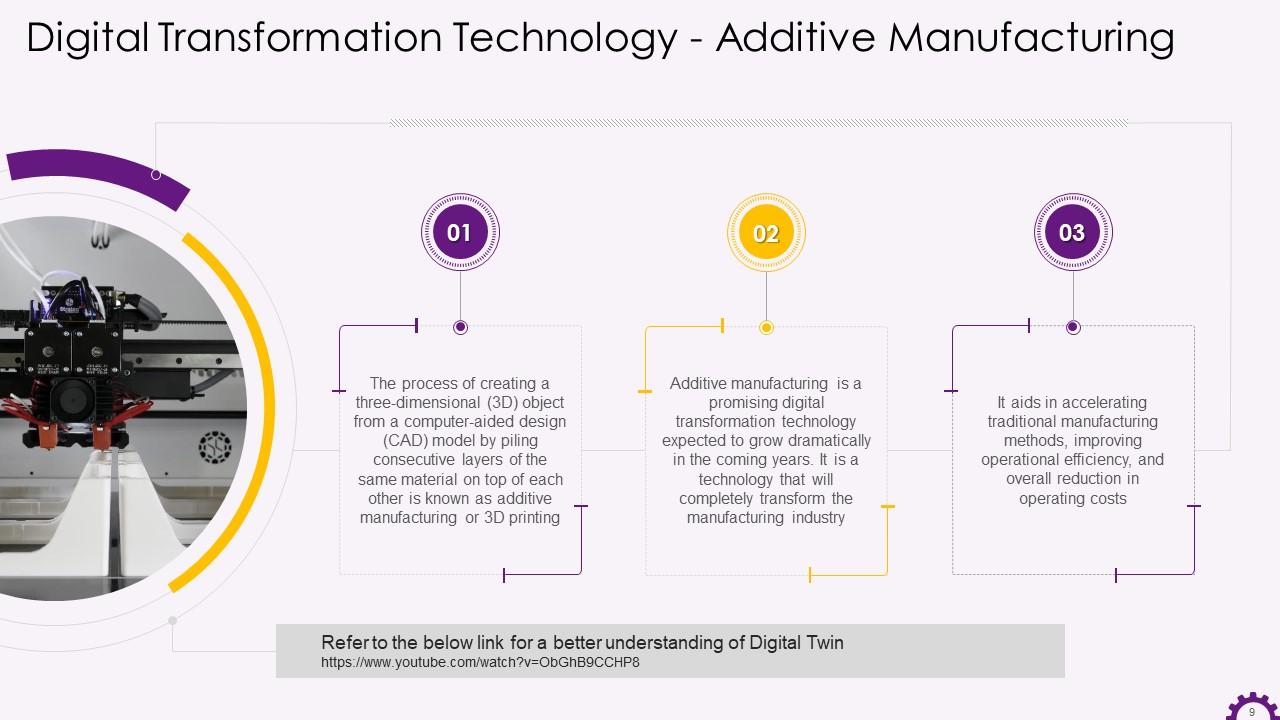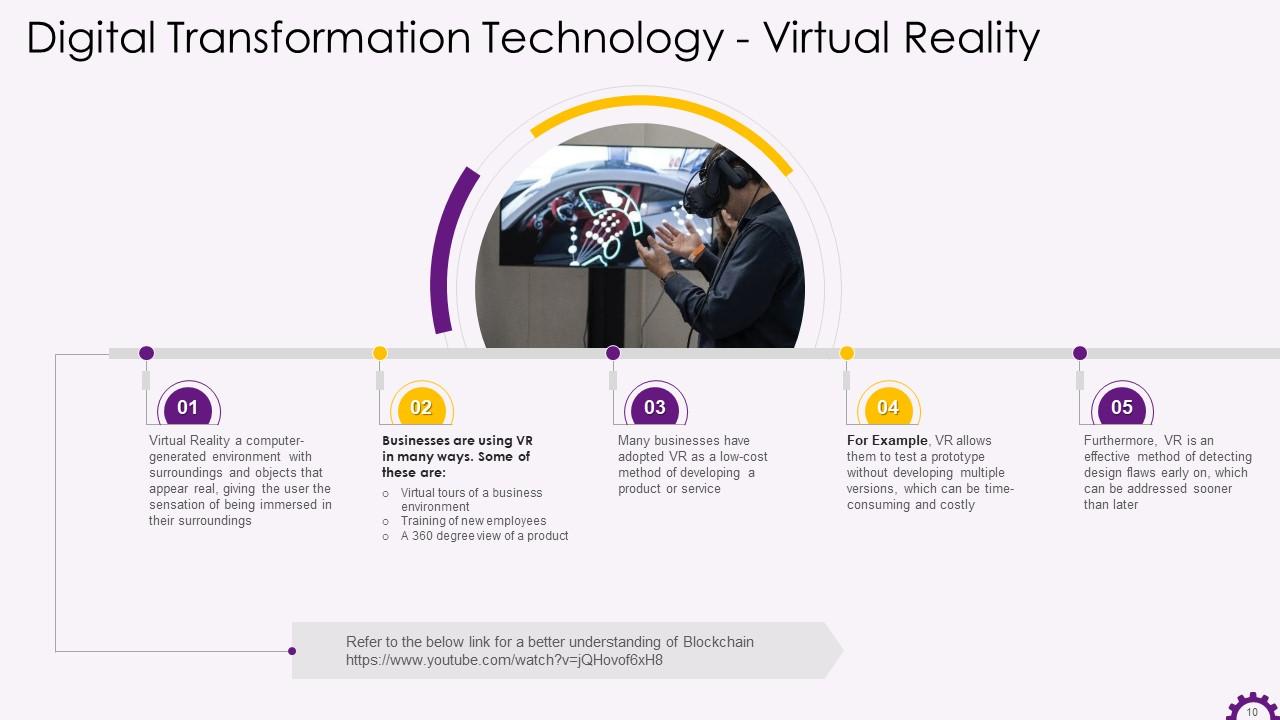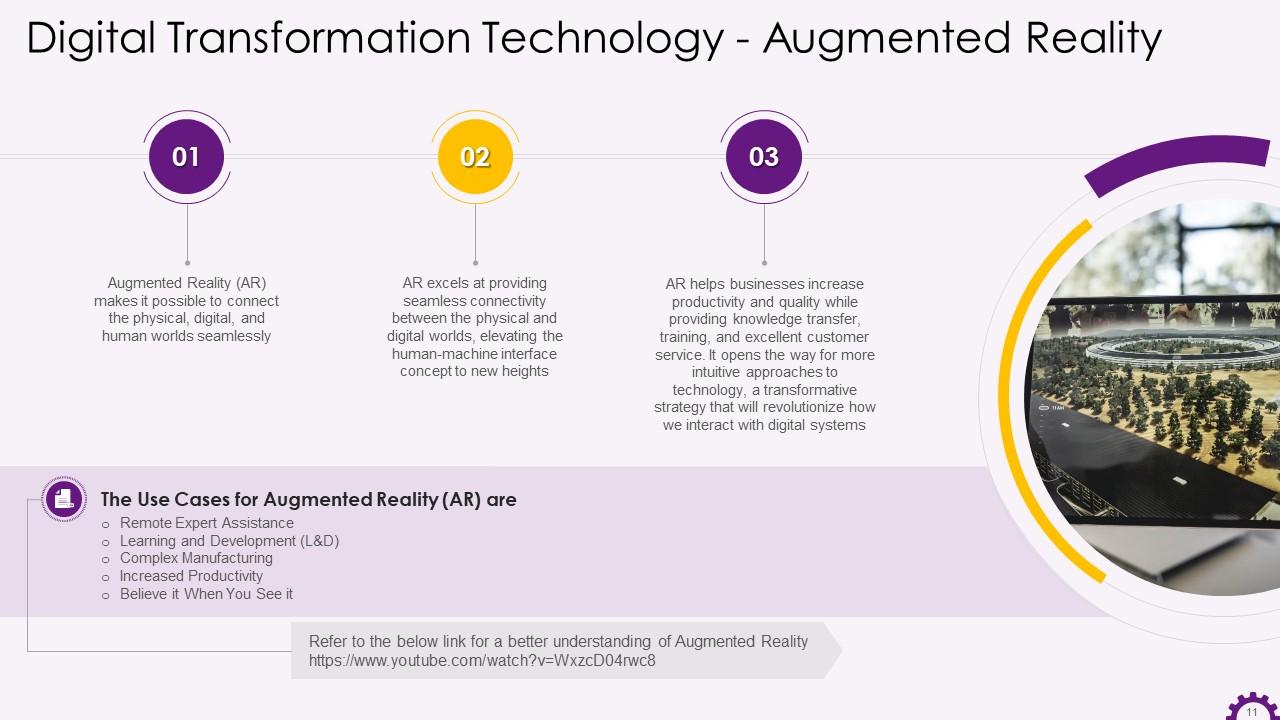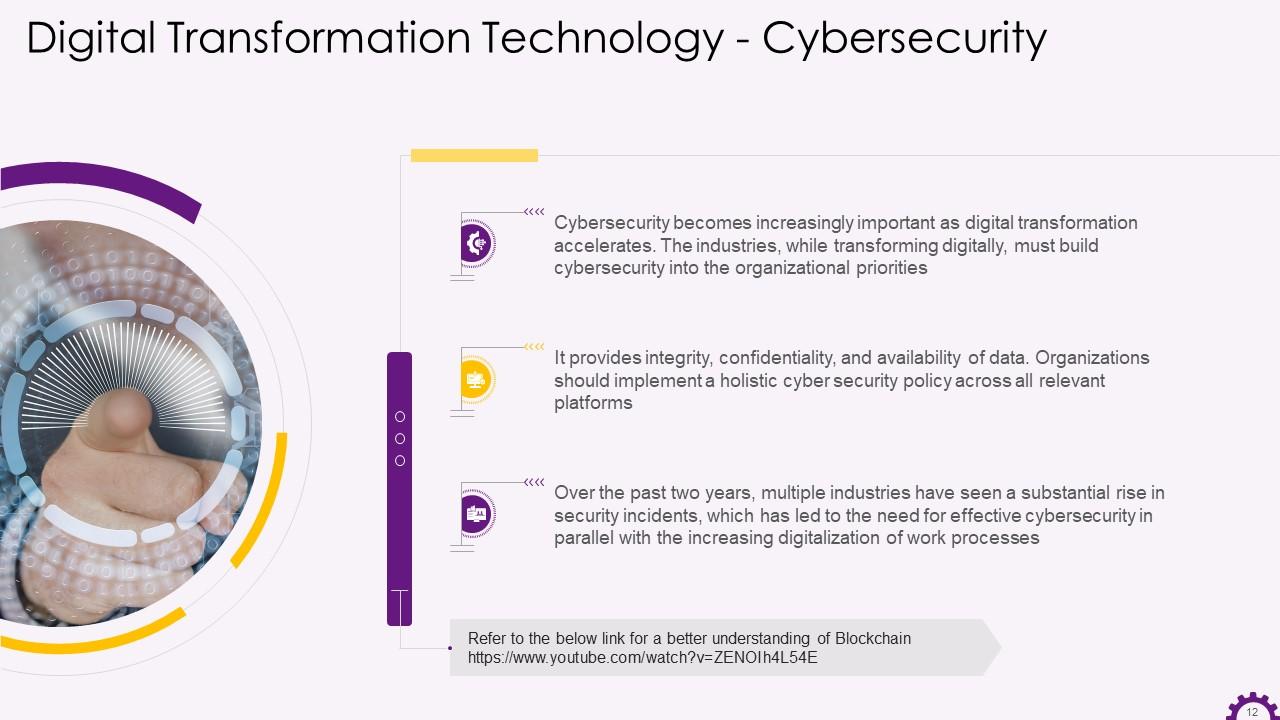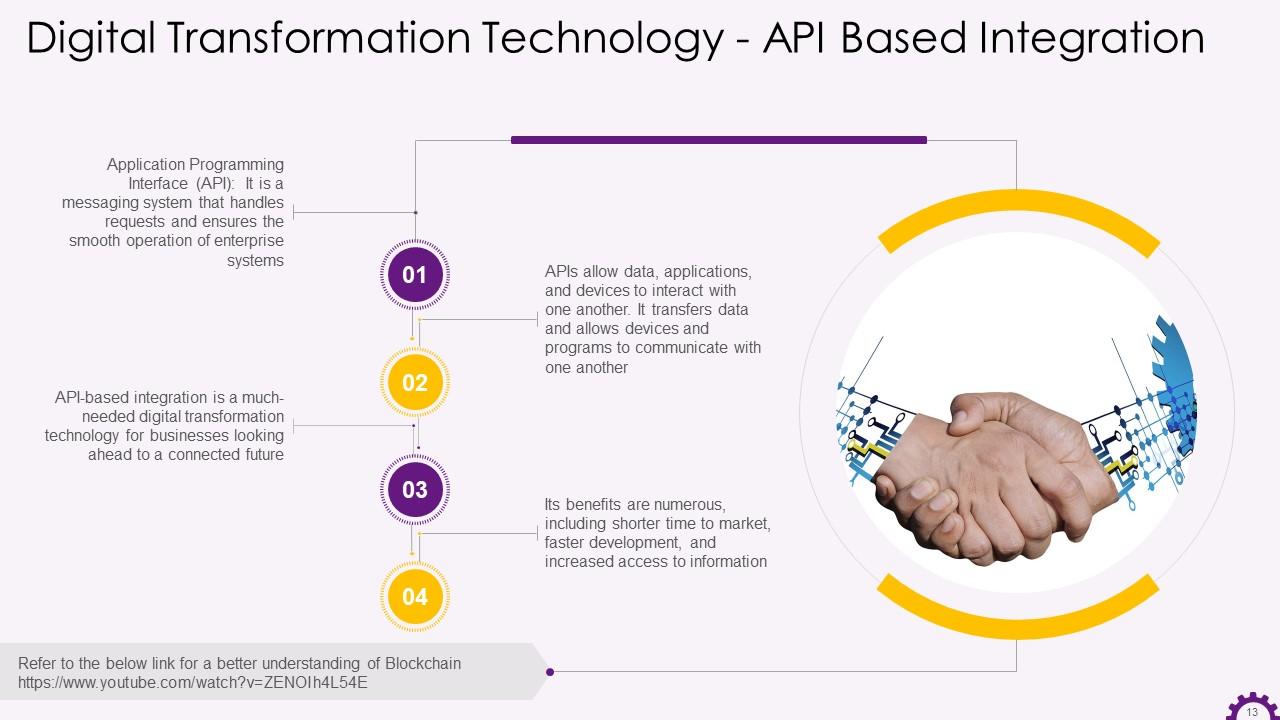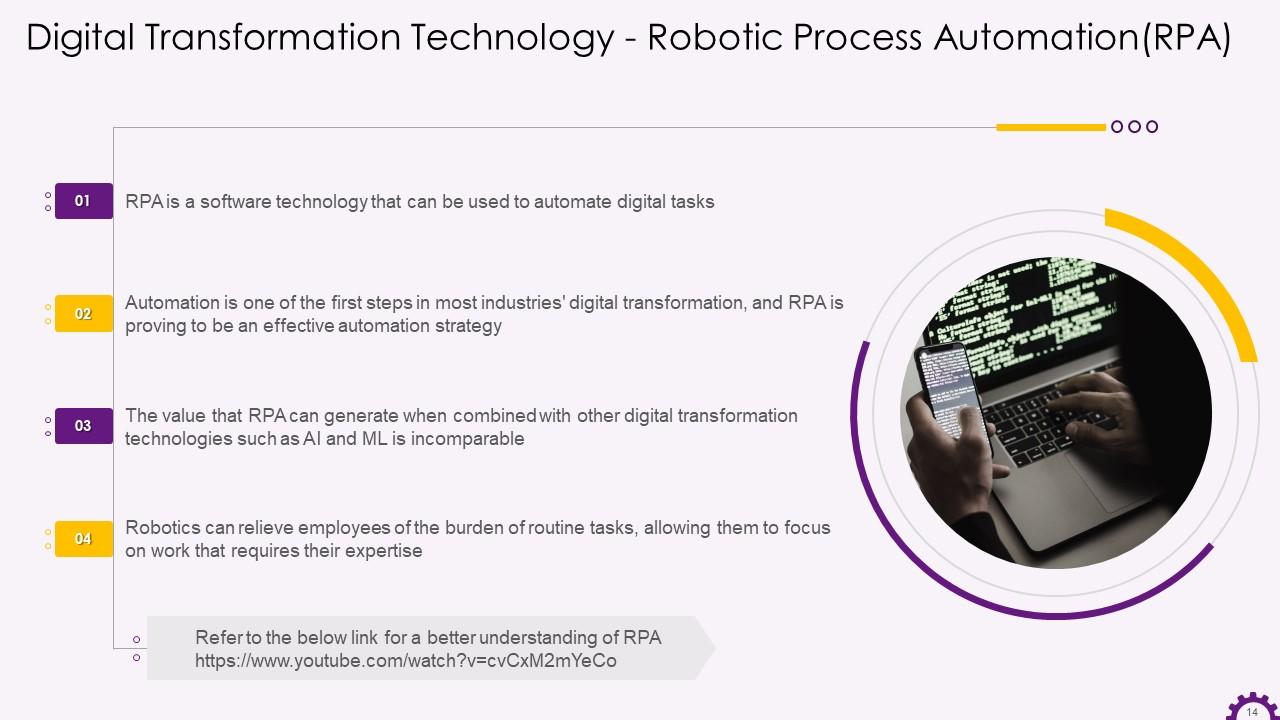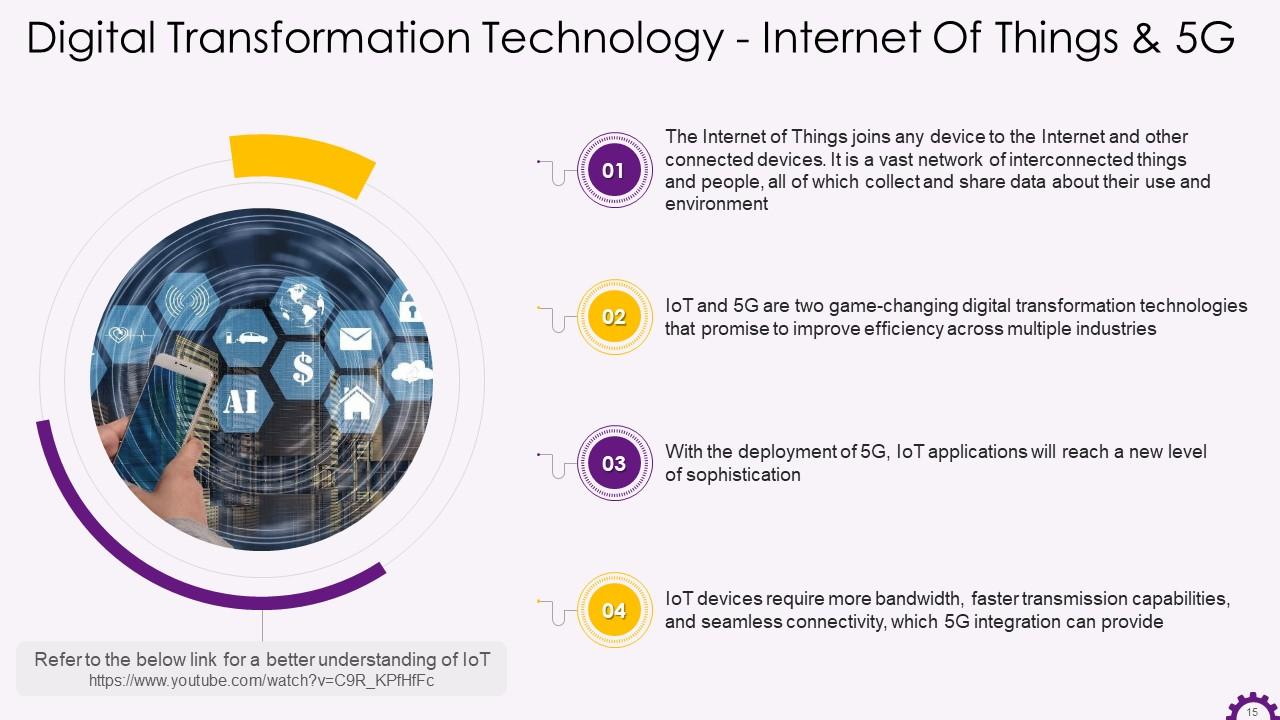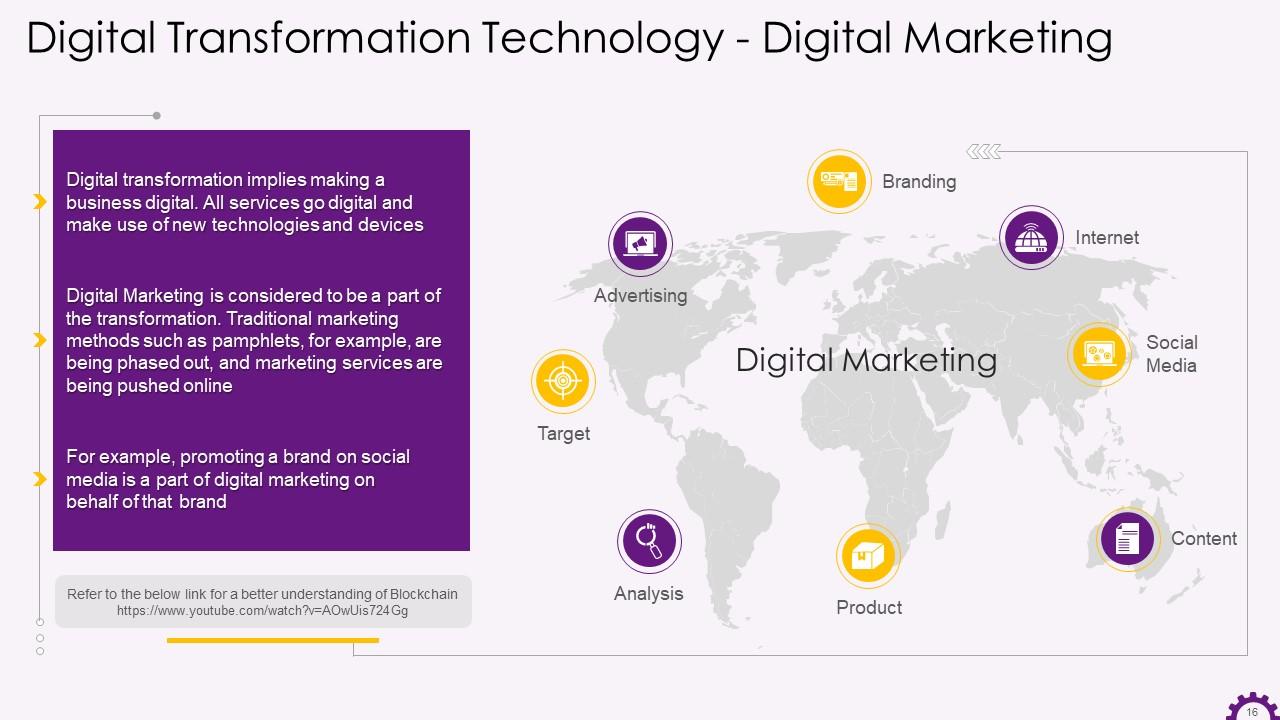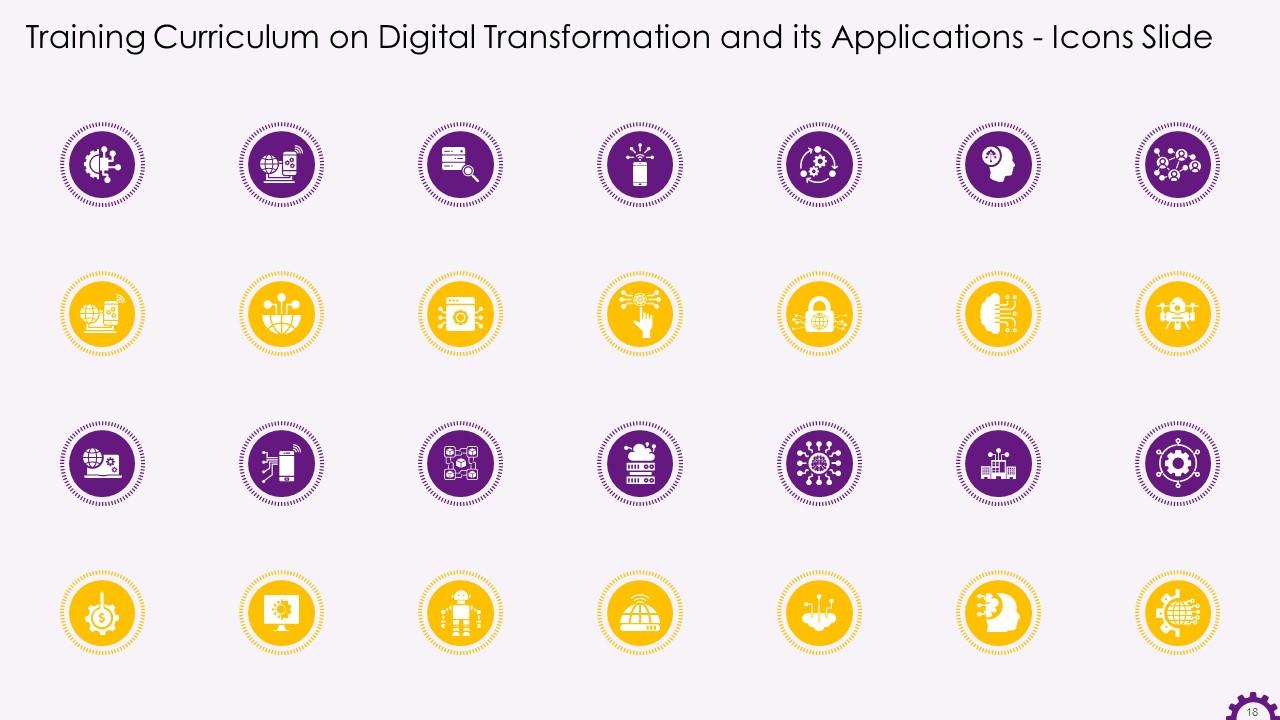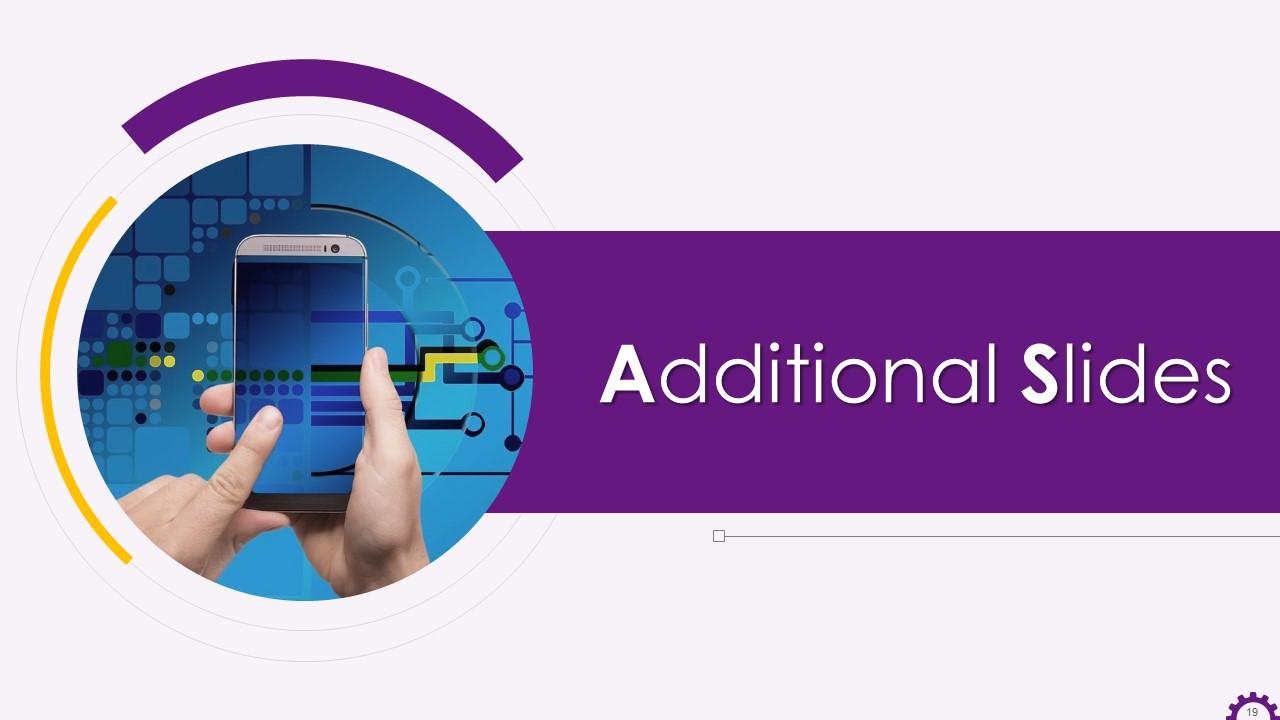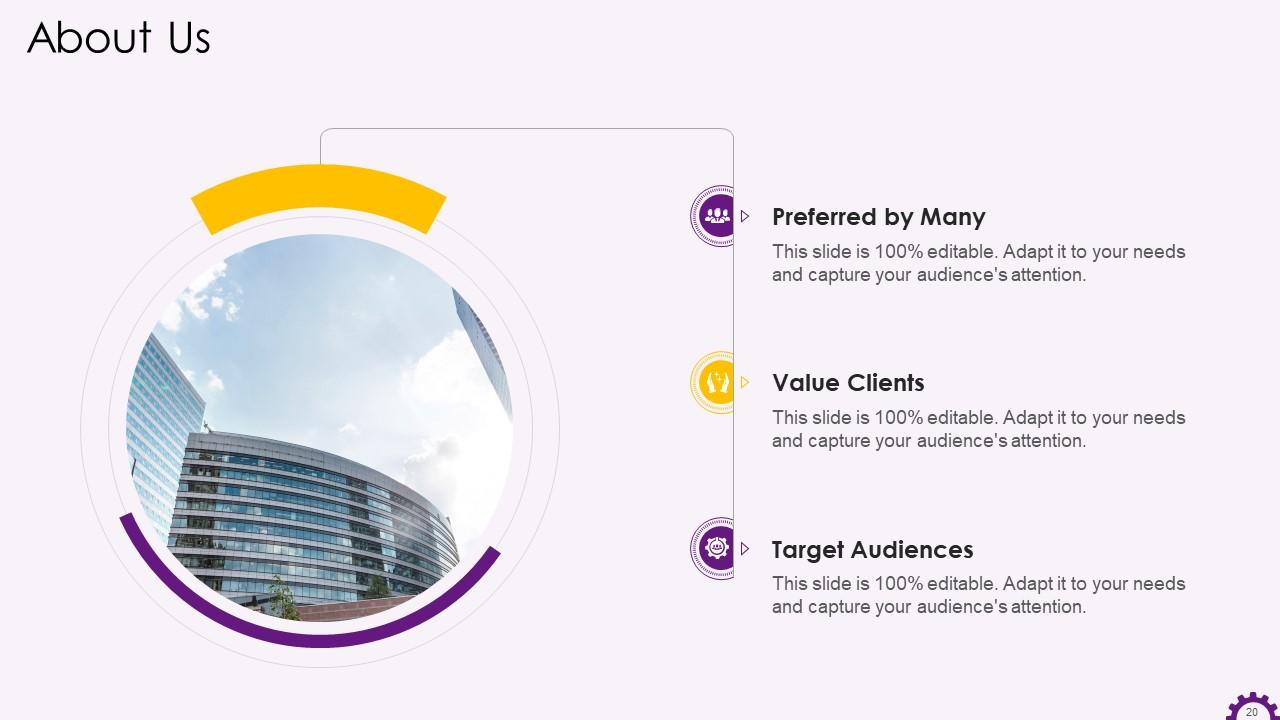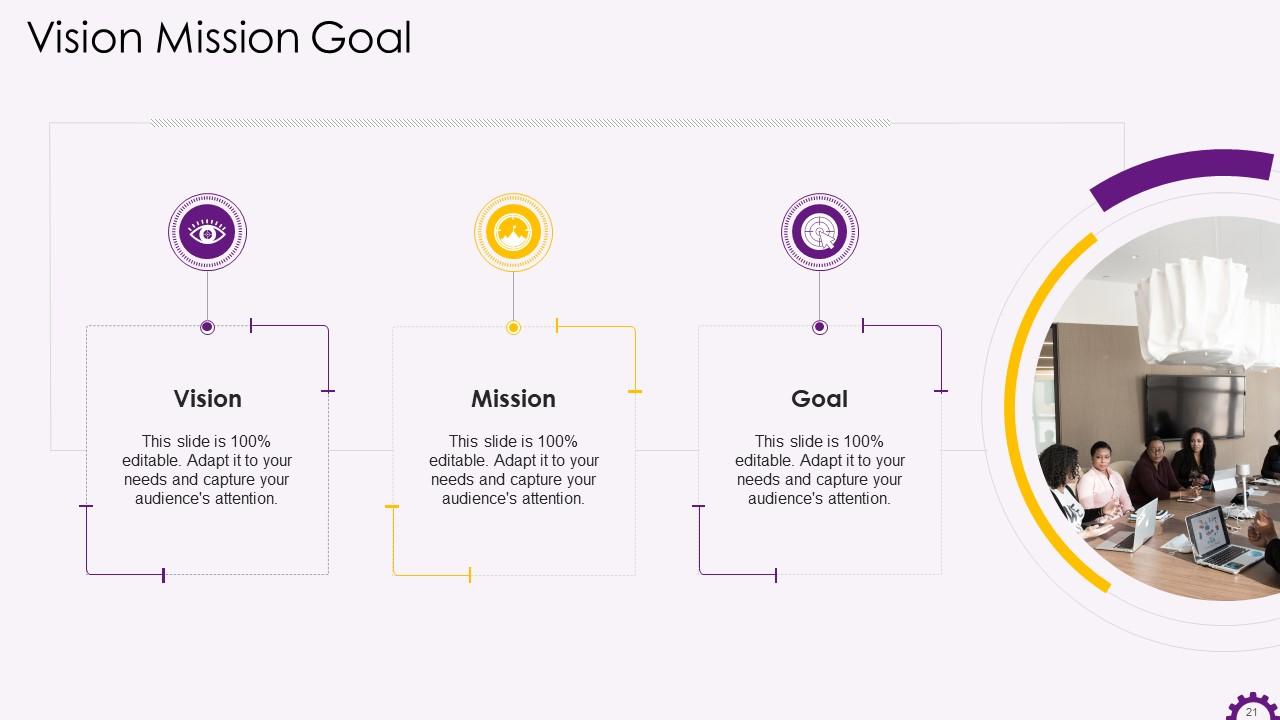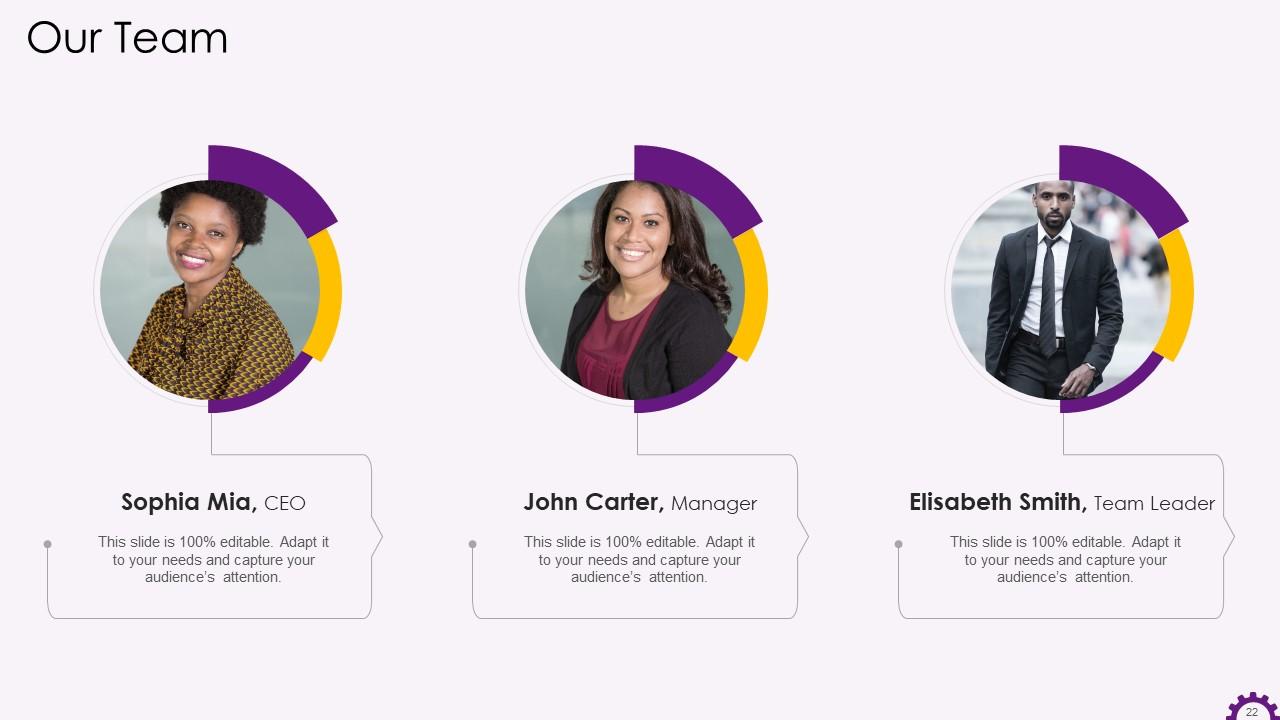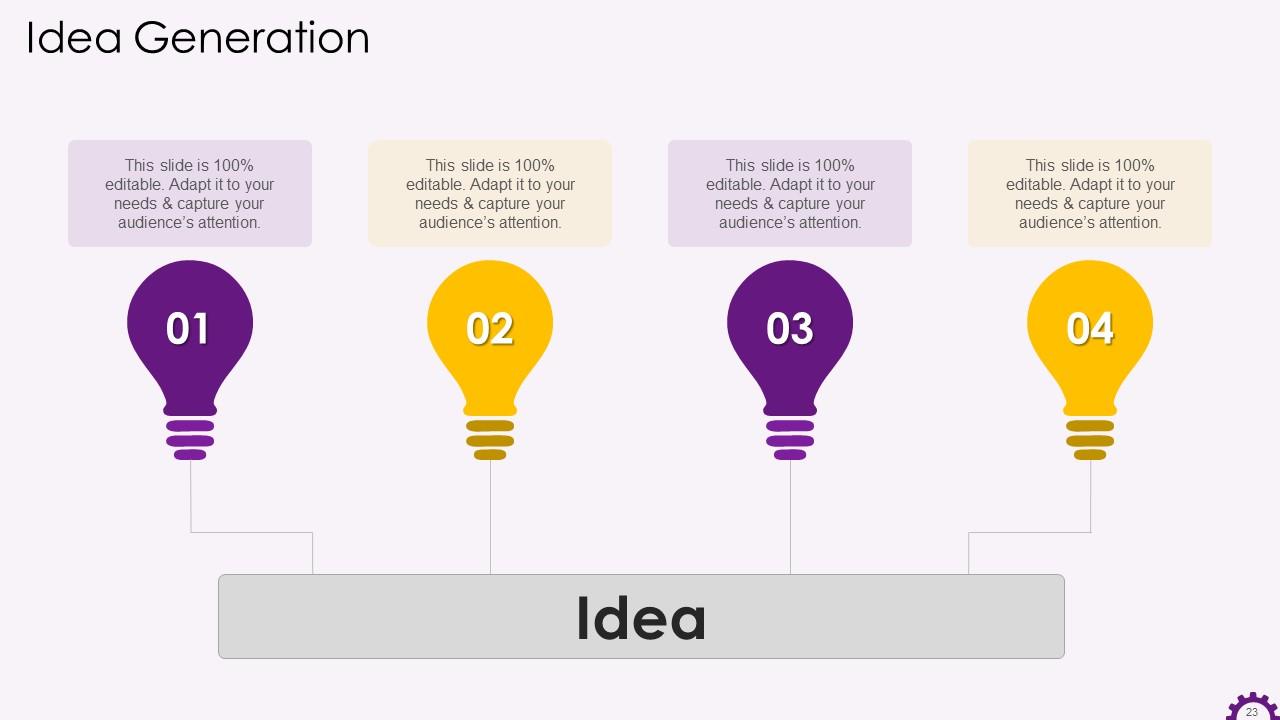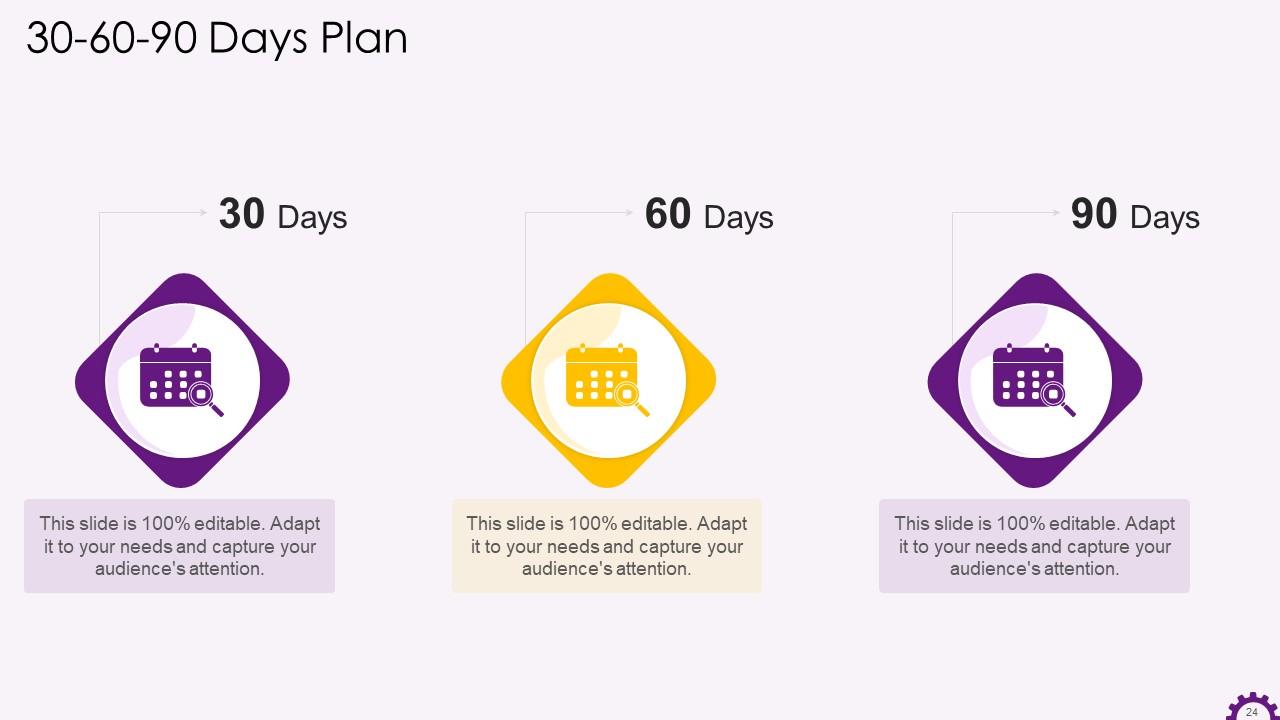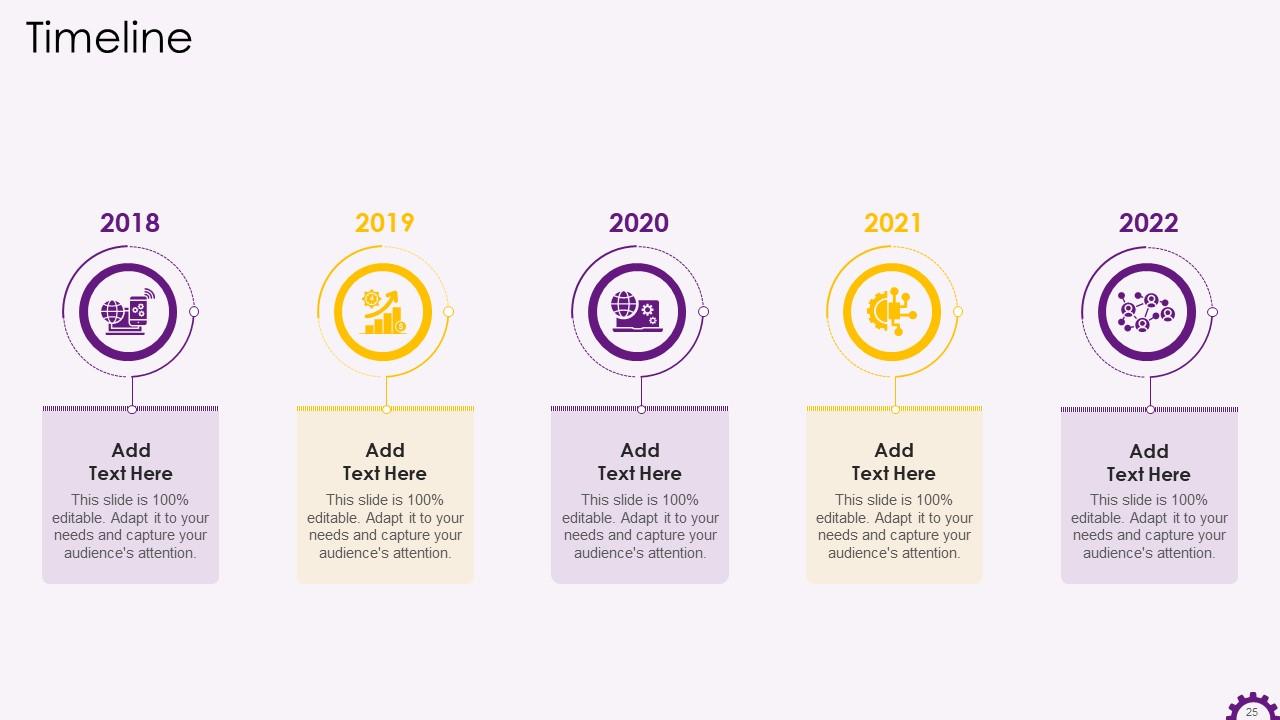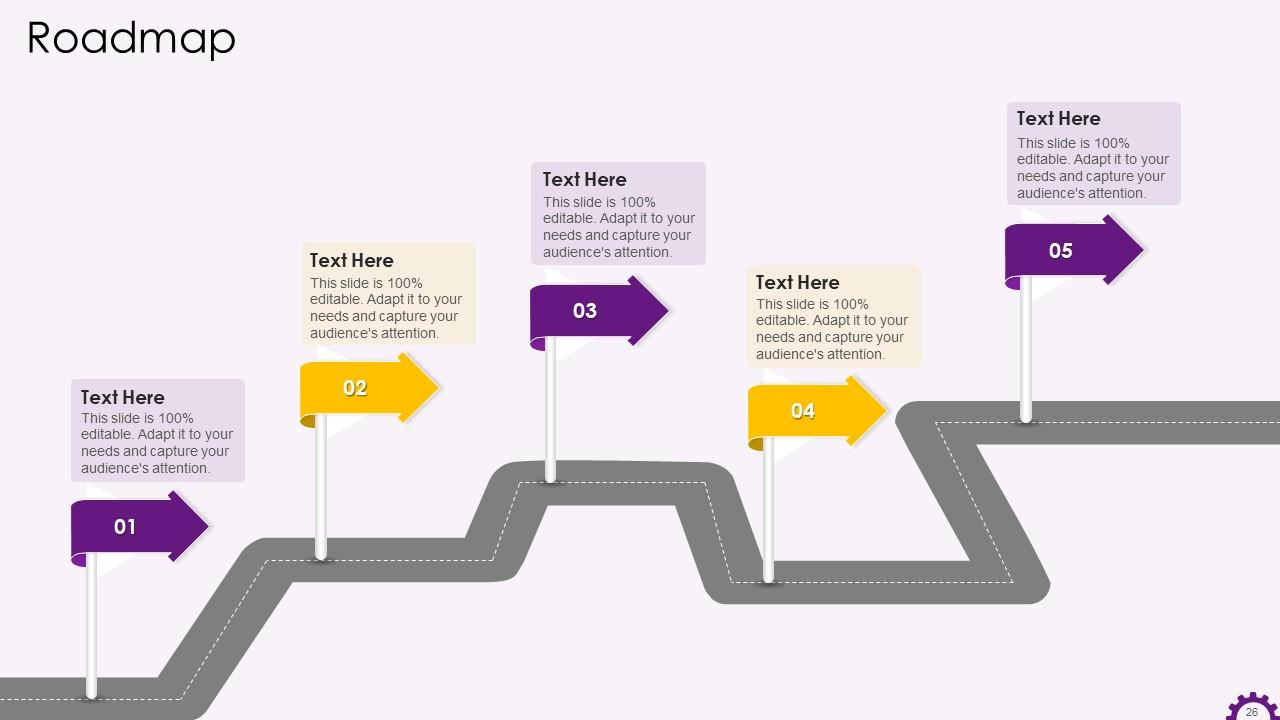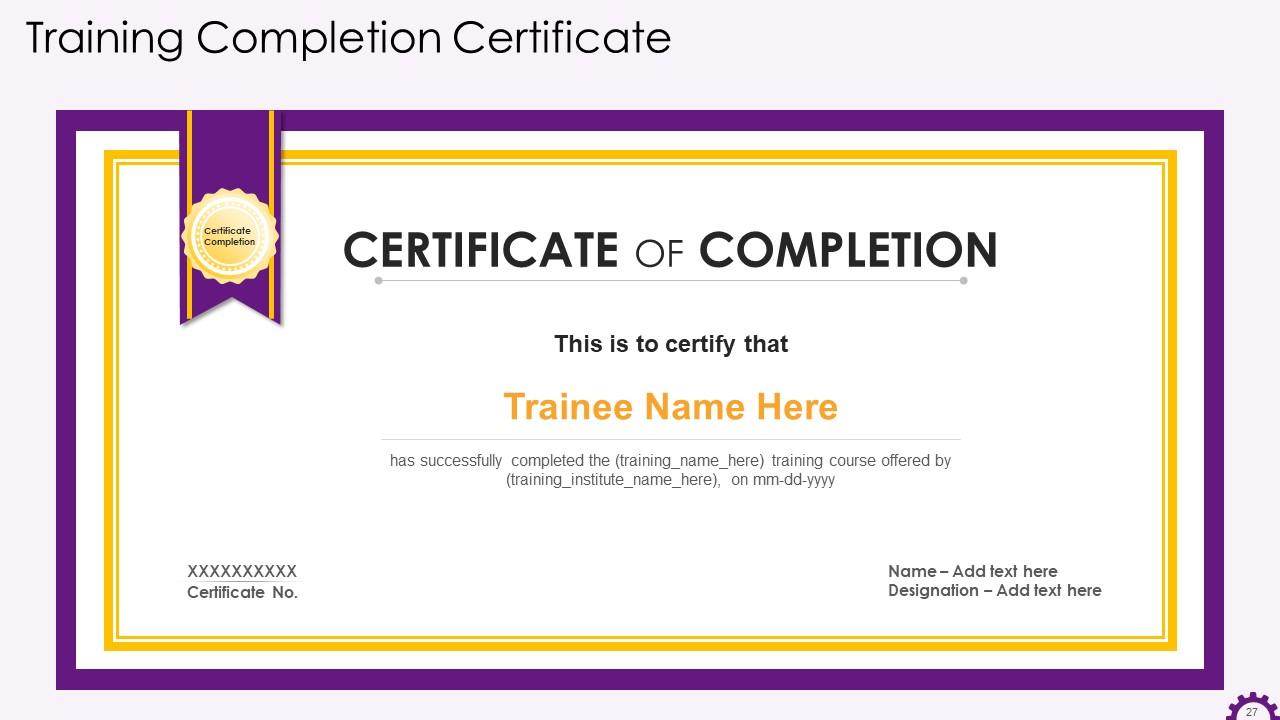Technologies Used In Digital Transformation Training Ppt
These slides, in detail, cover the technologies used in business digital transformation technologies such as big data, blockchain, artificial intelligence, machine learning, drones, robots, cloud computing, digital twin, additive manufacturing, virtual reality, augmented reality, cybersecurity, API-based integration, robotic process automation, internet of things, and digital marketing.
- Google Slides is a new FREE Presentation software from Google.
- All our content is 100% compatible with Google Slides.
- Just download our designs, and upload them to Google Slides and they will work automatically.
- Amaze your audience with SlideTeam and Google Slides.
-
Want Changes to This PPT Slide? Check out our Presentation Design Services
- WideScreen Aspect ratio is becoming a very popular format. When you download this product, the downloaded ZIP will contain this product in both standard and widescreen format.
-

- Some older products that we have may only be in standard format, but they can easily be converted to widescreen.
- To do this, please open the SlideTeam product in Powerpoint, and go to
- Design ( On the top bar) -> Page Setup -> and select "On-screen Show (16:9)” in the drop down for "Slides Sized for".
- The slide or theme will change to widescreen, and all graphics will adjust automatically. You can similarly convert our content to any other desired screen aspect ratio.
Compatible With Google Slides

Get This In WideScreen
You must be logged in to download this presentation.
PowerPoint presentation slides
Presenting Commonly used Digital Transformation Technologies. These slides are well crafted and designed by our PowerPoint specialists. This PPT presentation is thoroughly researched by the experts, and every slide consists of appropriate content. You can add or delete the content as per your need.
People who downloaded this PowerPoint presentation also viewed the following :
Content of this Powerpoint Presentation
Slide 1
This slide illustrates digital transformation technologies. The technologies are Big Data, Blockchain, Artificial Intelligence and Machine Learning, Drones, Robots, Cloud Computing, Digital Twin, Cybersecurity, API Based Integration, Robotic Process Automation, Digital Marketing, Internet of Things, Additive Manufacturing, Virtual Reality, and Augmented Reality.
Slide 2
This slide depicts information regarding big data analytics. It also highlights that it is feasible to process vast amounts of data using big data analytics to extract the right information for a specific business to help them model their strategies and make relevant decisions.
Slide 3
This slide illustrates information regarding Blockchain. It highlights that Blockchain stores data in blocks that are linked together using cryptography. It also highlights the applications of Blockchain such as Blockchain for Digital Transactions Management, supply chain, smart contracts, etc.
Slide 4
This slide depicts information regarding artificial intelligence and machine learning. It also illustrates that businesses of all sizes are using Artificial Intelligence to help with operations and decision-making. Both AI and machine learning have improved performance in the automotive, healthcare, retail, information technology industries, etc.
Slide 5
This slide mentions the significance and use cases of drone technology in digital transformation. It says that drones can deliver strategic and competitive advantages along with efficiency gains. Drone technology, when combined with analytics and a computing platform, integrates digital solutions to harness the power of SMAC (social, mobile, analytics and cloud). The possible use cases of drone technology are delivery of medicines, aerial photography, gathering of information, rescue operations, mapping of inaccessible terrain, etc.
Slide 6
This slide mentions the significance and use cases of robotic technology in digital transformation. It says that Robots help boost productivity, improve safety, and ensure time saving.Robots can produce incredibly accurate, consistent, and high-quality results without the need for breaks or holidays. The use cases of robotics technology are order processing, surgeries, inventory management, manufacturing, etc.
Slide 7
This slide showcases information on cloud technology. It also depicts that Cloud computing provides servers, databases, software storage, networking, analytics, and intelligence over the Internet ("the cloud") to offer faster innovation, more flexible resources, and economies of scale. The slide also contains the business advantages of cloud computing such as cost-saving, security, flexibility, mobility, quality control, insight, loss prevention, disaster recovery, automatic software updates, competitive edge, etc.
Slide 8
This slide illustrates the information regarding the digital twin. It also highlights that the digital twin is a digital transformation technology connecting the physical and digital worlds. Digital twins are also being used in healthcare to improve diagnosis and are also used to optimize manufacturing in the automotive industry.
Slide 9
This slide depicts the information regarding additive manufacturing. It illustrates that additive manufacturing or 3D printing is the process of creating a three-dimensional object from a computer-aided design (CAD) model by piling consecutive layers of material on top of each other. It also aids in accelerating traditional manufacturing methods, improving operational efficiency, and reducing operating costs.
Slide 10
This slide illustrates information regarding virtual reality. It also highlights that virtual reality is being used in several ways by the business community, including virtual tours of a business environment, training of new employees, and a 360 degree view of a product.
Slide 11
This slide showcases the information regarding augmented reality. It also contains the use cases for augmented reality such as remote expert assistance, learning and development (L&D), complex manufacturing, increased productivity, and believe it when you see it.
Instructor’s Notes: The Use Cases for Augmented Reality (AR) are:
- Remote Expert Assistance: AR enables experts to be in more than one place simultaneously. If a field technician in a remote location becomes stuck while troubleshooting some equipment, they can use an enterprise AR solution to connect with the subject-matter expert (SME). The SME could be at the home, office, or even on the other side of the world. This not only allows the expert to see what the technician is looking at, but it also allows them to provide instructions directly on top of the target. For Example: Instead of saying which screw to remove, they could draw a circle on top of it
- Learning and Development (L&D): AR enables organizations to train employees from any location. It allows operators to gain hands-on experience with patients, machinery, and equipment in a risk-free environment.
- Complex Manufacturing: Manufacturing is already being transformed by augmented reality. It is one of the most important technologies for Industry 4.0. On the factory floor, operators and engineers use augmented reality glasses to aid in troubleshooting, manage configurations reliably, and build complex machinery. For Example: Boeing's AR program, which overlays digital 3D wiring diagrams on KC-46 tankers and 767 freighters to speed up manufacturing and ensure accuracy
- Increased Productivity: Productivity gains extend far beyond the manufacturing industry. One important application of AR is customer experience. For Example: AR significantly improves the effectiveness of a helpdesk. Customer service representatives can see what the customer sees, also known as see-what-I-see (SWIS). They can analyze the problem with their eyes and use the digital overlay to guide the customer through the repair/installation process. This increases productivity by reducing call durations
- Believe it When You See it: Seeing something with one's own eyes has extraordinary power. AR allows seeing prototypes in a less expensive, more straightforward, and more accessible manner. Augmented reality applications give marketing teams a valuable new tool to add to their toolbox. Whether in a B2B or B2C context, showing a customer a product that they can visualize or interact with is a significant advantage
Slide 12
This slide mentions the significance and use cases of cybersecurity in digital transformation. It says that Cybersecurity ensures confidentiality, integrity, and availability of data. Organizations should implement a holistic cyber security policy across all relevant platforms.
Slide 13
This slide depicts the data for API-based Integration. It also states that an Application Programming Interface (API) is a messaging system that handles requests and ensures that enterprise systems run smoothly. API-based integration is a critical digital transformation technology for companies preparing for a connected future.
Slide 14
This slide demonstrates the information on Robotic Process Automation (RPA). It also depicts that RPA is a software technology that can be used to automate digital tasks. The value that RPA can generate when combined with other digital transformation technologies such as AI (Artificial Intelligence) and ML (Machine Learning) is incomparable.
Slide 15
This slide illustrates the information regarding the Internet Of Things and 5G. It also demonstrates that IoT and 5G are two game-changing digital transformation technologies that promise to improve efficiency across multiple industries. IoT devices require more bandwidth, faster transmission capabilities, and seamless connectivity, which 5G integration can provide.
Slide 16
This slide showcases the information regarding digital marketing. It also highlights that Digital transformation implies making the business digital. All the services go digital and make use of new technologies and devices. It also mentions that digital marketing is considered to be a part of the transformation. Traditional marketing methods such as pamphlets, for example, are being phased out, and marketing services are being pushed online.
Technologies Used In Digital Transformation Training Ppt with all 32 slides:
Use our Technologies Used In Digital Transformation Training Ppt to effectively help you save your valuable time. They are readymade to fit into any presentation structure.
-
Presentation Design is very nice, good work with the content as well.
-
Love the template collection they have! I have prepared for my meetings much faster without worrying about designing a whole presentation from scratch.


